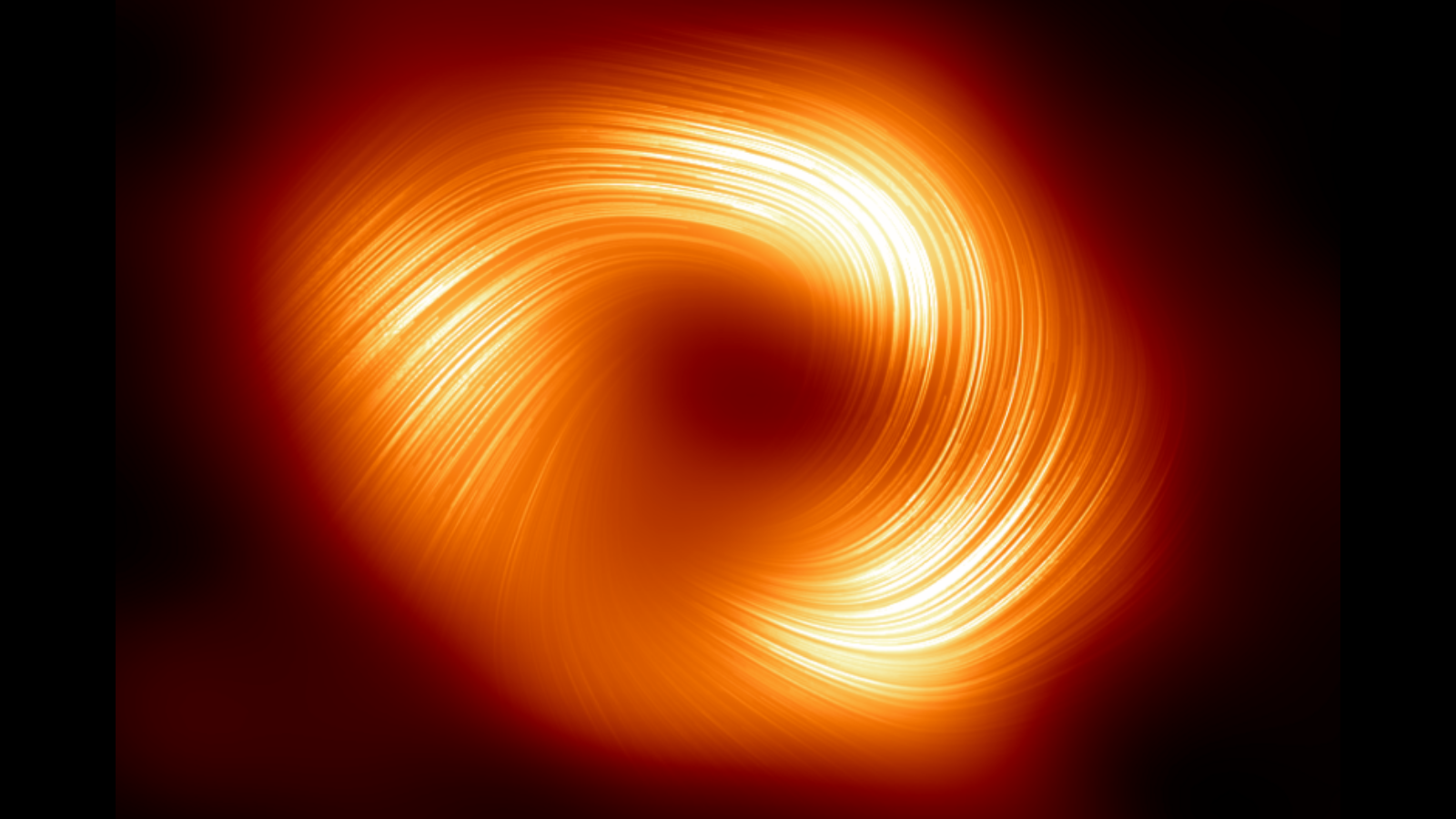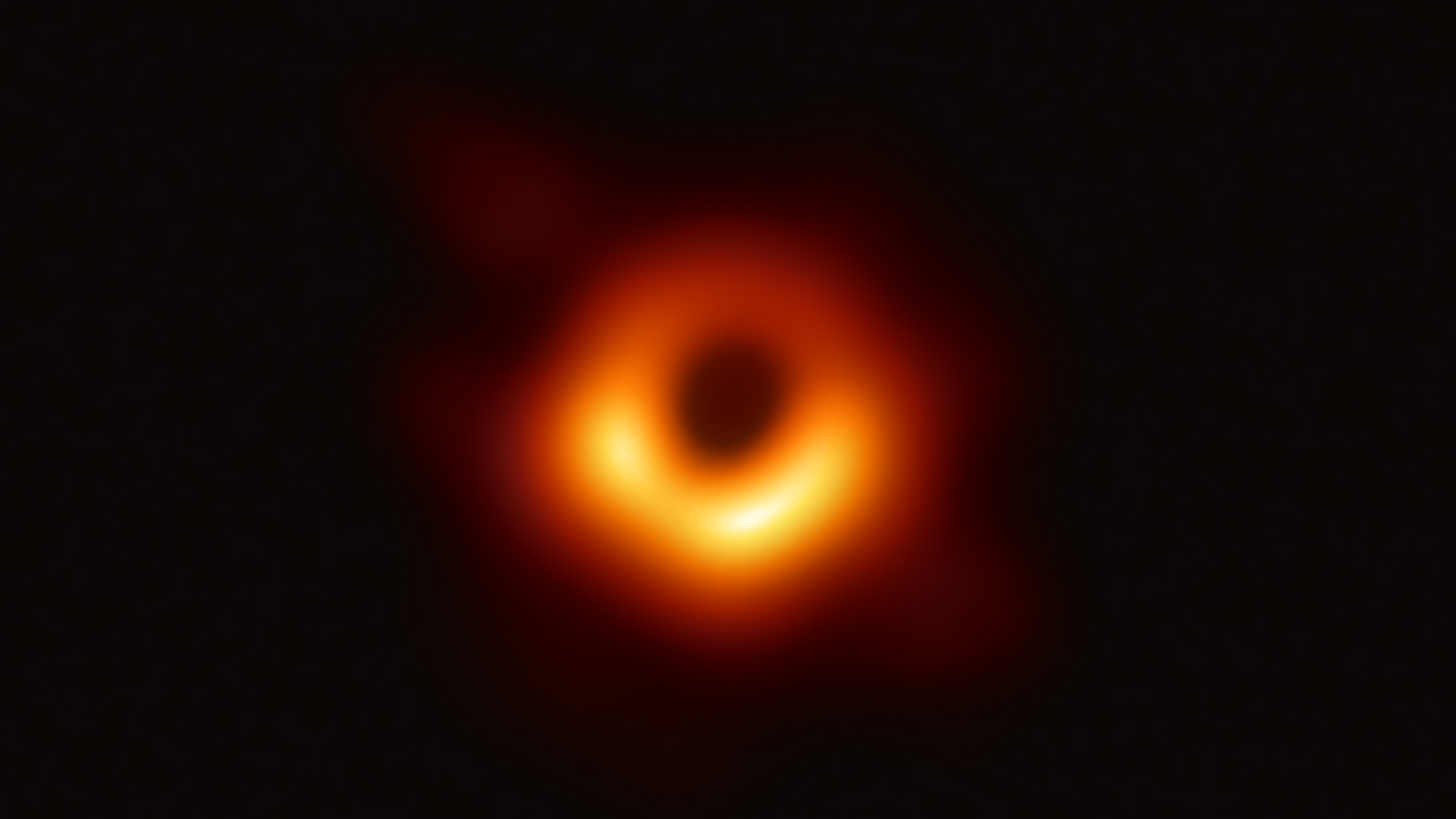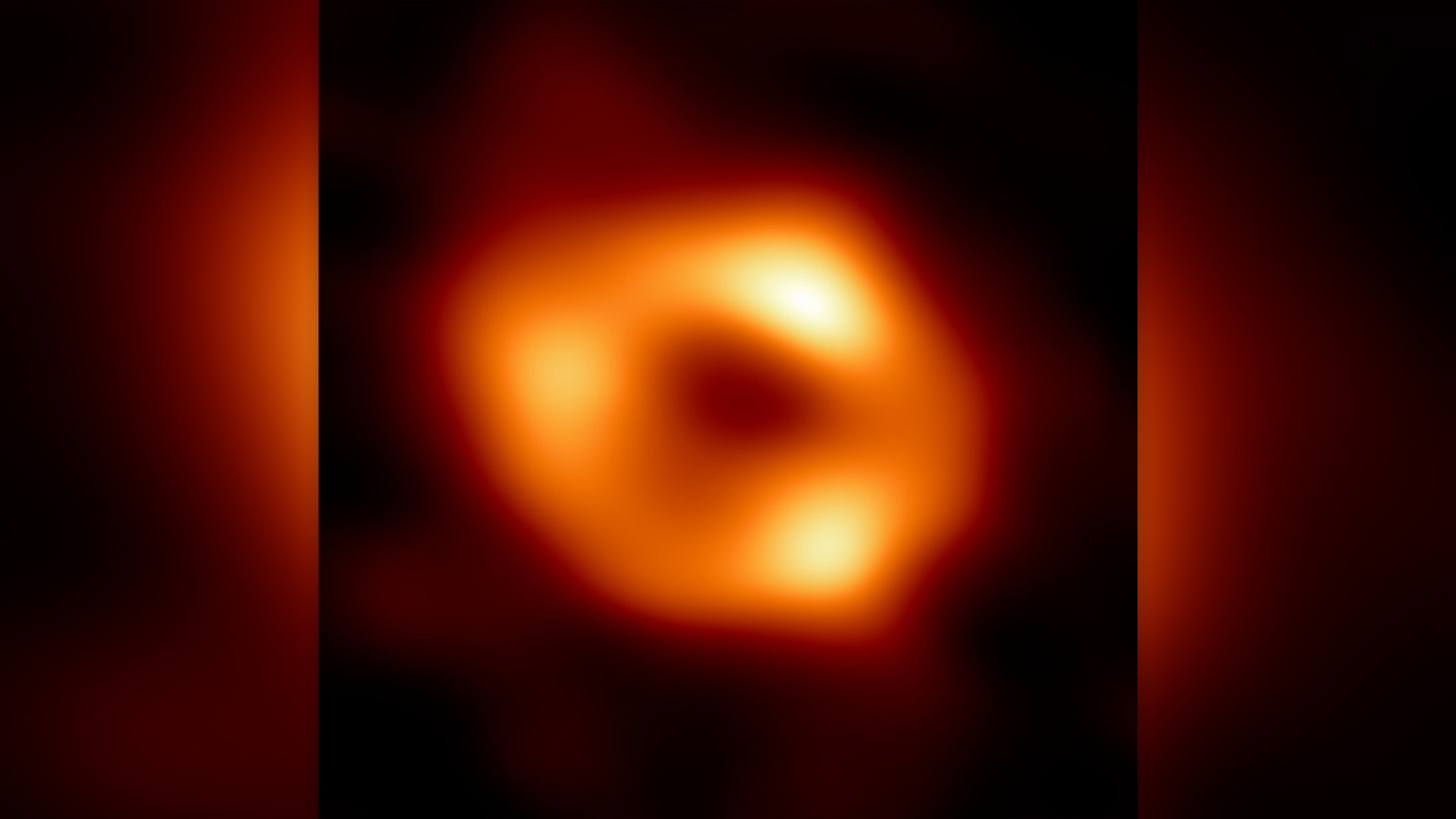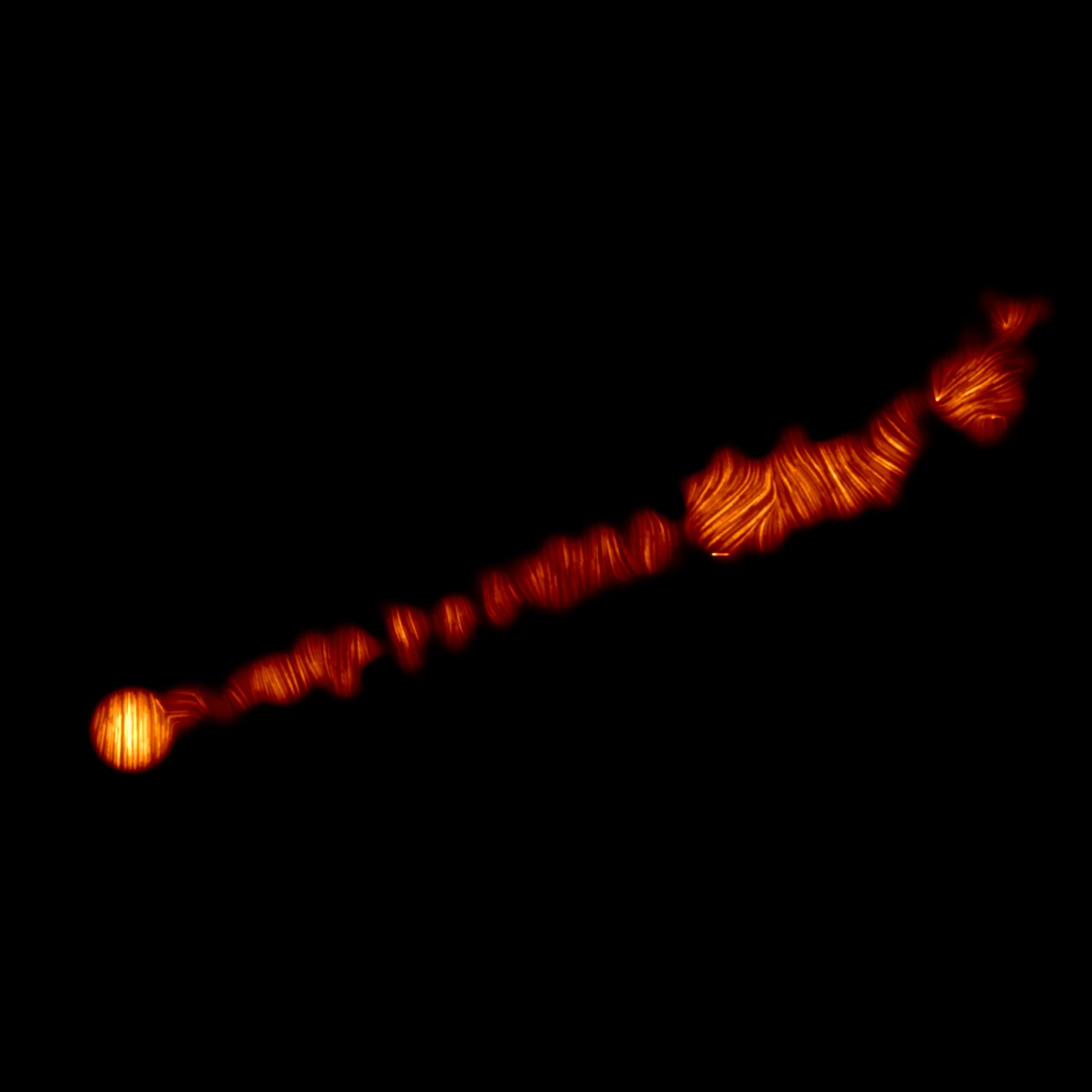New view of the supermassive black hole at the heart of the Milky Way hints at an exciting hidden feature (image)
"Perhaps there is also a jet lurking in Sagittarius A* waiting to be observed, which would be super exciting!"
Astronomers have captured the first view of polarized light and the magnetic fields that surround Sagittarius A* (Sgr A*), the supermassive black hole at the heart of the Milly Way.
The historic observation made with the Event Horizon Telescope (EHT) has revealed the neatly ordered magnetic fields have similarities with those that surround the supermassive black hole at the heart of the galaxy M87. This is surprising given that Sgr A* has a mass of around 4.3 million times that of the sun, but M87* is much more monstrous, with a mass equivalent to around 6.5 billion suns.
The new EHT observation of Sgr A*, therefore, suggests that strong and well-organized magnetic fields could be common to all black holes. Also, because M87*'s magnetic fields drive powerful outflows or "jets," the results hint that Sgr A* could have a hidden and faint jet all of its own.

"This new image of the black hole at the center of our Milky Way, Sgr A*, tells us that near the black hole are strong, twisted, and ordered magnetic fields," Sara Issaoun, research co-leader and NASA Hubble Fellowship Program Einstein Fellow at the Center for Astrophysics (CfA) at Harvard & Smithsonian told Space.com "For a while, we've believed that magnetic fields play a key role in how black holes feed and eject matter in powerful jets.
"This new image, along with a strikingly similar polarization structure seen in the much larger and more powerful M87* black hole, shows that strong and ordered magnetic fields are critical to how black holes interact with the gas and matter around them."
Comparing the magnetism of two monster black holes
The EHT is comprised of many telescopes across the globe, including the Atacama Large Millimeter/submillimeter Array (ALMA), which come together to form an Earth-sized telescope that is no stranger to making scientific history.
Get the Space.com Newsletter
Breaking space news, the latest updates on rocket launches, skywatching events and more!
In 2017, the EHT captured the first image of a black hole and its environment, imaging M87* located around 53.5 million light-years from Earth. Two years after this image was revealed to the public in 2019, the EHT collaboration revealed the first look at polarized light around a black hole, M87*, once again.
Polarization happens when the orientation waves of light are directed at a particular angle. The magnetic fields generated by plasma whipping around black holes polarize light at a 90-degree angle to themselves. That means observing the polarization around M87* allowed scientists to "see" the magnetic fields around a black hole for the first time.

This was followed in 2022 by the revelation that the EHT had also imaged a supermassive black hole much closer to Earth at just 27,000 light-years away, Sgr A*, the black hole around which the Milky Way is sculpted.

Now, the EHT has finally provided scientists with an image of polarized light and, thus, the magnetic fields around this supermassive black hole.
"Polarized light is what teaches us about magnetic fields, the properties of the gas, and mechanisms that take place as a black hole feeds," Issaoun said. "Given the additional challenges to image Sgr A*, it is honestly surprising enough that we were able to get a polarization image in the first place!"
These challenges arose despite Sgr A* being closer to Earth, because the smaller size of the Milky Way's supermassive black hole means that the material that whips around it at near light-speeds is difficult to image. M87* is much larger, meaning the material, while traveling at the same speed, more or less, takes much longer to complete a circuit, making it easier for the EHT to capture.
Overcoming these difficulties means a comparison can now be made between two black holes at the opposite ends of the supermassive black hole spectrum, one with billions of times the mass of the sun and another with a mass millions of times that of our star. The initial conclusion is these magnetic fields are remarkably similar to one another.

"This similarity was especially surprising because M87* and Sgr A* are very different black holes," Issaoun said. "M87* is quite a special black hole: It is 6 billion solar masses, it lives in a giant elliptical galaxy, and it ejects a powerful jet of plasma visible at all wavelengths.
"Sgr A*, on the other hand, is extremely common: It is 4 million solar masses, it lives in our ordinary spiral Milky Way galaxy, and it doesn’t seem to have a jet at all."
Issaoun explained that just by looking at the portion of the light that is polarized, the team had expected to learn about the different properties of the magnetic fields of M87* and Sgr A*.
"Perhaps one would be more ordered and strong, and the other more disordered and weak," Issaoun added. "However, because they look similar again, it is now quite clear that these two different classes of black holes have very similar magnetic field geometry!"
The results suggest a deeper investigation of Sgr A* may uncover hitherto undiscovered features.
Is the Milky Way's supermassive black hole launching a hidden jet?
The polarization of light and neat and strong magnetic fields of Sgr A*, and the fact that they closely resemble that of M87*, may indicate that our central black hole has been hiding a secret from us until now.
"We expect strong and ordered magnetic fields to be directly linked to the launching of jets as we observed for M87*," Issaoun explained. "Since Sgr A*, with no observed jet, seems to have a very similar geometry, perhaps there is also a jet lurking in Sgr A* waiting to be observed, which would be super exciting!"
Astronomers hadn't been terribly surprised not to see a jet from Sgr A*. That's because M87* is surrounded by so much gas and dust that it consumes the equivalent of two or three suns each year. That means plenty of material for its magnetic fields to channel to its poles and blast out as jets.
Sgr A*, on the other hand, consumes so little matter it is equivalent to a human being eating one grain of rice every million years. These observations suggest that our dieting supermassive black hole may still have a jet; it is just difficult to see.
"There is a lot of evidence of possible outflows and even jets powered by the black hole in the past, yet a jet in Sgr A* has never been imaged due to the difficult environment of the galactic center," Issaoun said."Finding a jet would be a major revelation about our black hole and a link to its history within our Milky Way."
She added that the process that launches these jets is the most energetic mechanism in the entire universe, dramatically affecting the heart of galaxies by, for instance, clearing out the gas and dust needed to birth stars and influencing how galaxies grow and evolve. That means discovering a jet emerging from Sgr A* would influence our understanding of how the Milky Way evolved to take the shape astronomers observe today.
"It is so striking that such large-scale damage can be caused by such a small nucleus in a galaxy, and it all starts at the edge of the central black hole, where these magnetic fields rule," Issaoun continued.

Issaoun said that with these two polarized images of very different black holes, scientists now have very compelling evidence that strong magnetic fields are ubiquitous to these cosmic titans.
"The next step," she said, "involves figuring out how that geometry connects to how these systems move, evolve, and flare."
The EHT will kick off its 2024 observing campaign in early April, with the collaboration hoping to get multi-color views of familiar black holes like M87* and Sgr A* by observing them in different frequencies of light.
"In the next decade, the next-generation EHT effort aims to add more telescopes to fill in our Earth-sized virtual mirror and observe a lot more often," Issaoun added. "With these expansions of the EHT, we will be able to make polarized movies of black holes and will directly observe the dynamics between the M87* black hole and its jet."
Additionally, the CfA researcher said the EHT could eventually get some space-based help observing black holes and their dynamics. One proposed mission that could assist in this is the Black Hole Explorer (BHEX) mission concept, which adds a single space telescope to the Earth-based EHT array.
"How much black holes rotate, their spin is believed to be directly connected to why magnetic fields near the black hole look the way they look and how they can launch jets," Issaoun concluded. "With BHEX, we could image the sharp photon ring signature of black holes. This photon ring encodes properties of the spacetime around the black hole, including the black hole's spin!"
The EHT team's research was published on Wednesday (March 27) in the Astrophysical Journal Letters.
Join our Space Forums to keep talking space on the latest missions, night sky and more! And if you have a news tip, correction or comment, let us know at: community@space.com.

Robert Lea is a science journalist in the U.K. whose articles have been published in Physics World, New Scientist, Astronomy Magazine, All About Space, Newsweek and ZME Science. He also writes about science communication for Elsevier and the European Journal of Physics. Rob holds a bachelor of science degree in physics and astronomy from the U.K.’s Open University. Follow him on Twitter @sciencef1rst.
NASA spacecraft spots monster black hole bursting with X-rays 'releasing a hundred times more energy than we have seen elsewhere'
Could we use black holes to power future human civilizations? 'There is no limitation to extracting the enormous energy from a rotating black hole'
-
Classical Motion When they first showed those pics a few years ago, I commented on how that was not a drain.....but a braid of plasma. A helical rotation. And that there was a M dipole in the center. And that it was the engine for our bubbles.Reply
There is no such thing as a black hole. Matter can NOT superposition. -
ianwhi16 Reply
According to everyone with a clue it is a black hole. Want to explain the stellar orbital dynamics around such a thing if it is just plasma woo?Classical Motion said:When they first showed those pics a few years ago, I commented on how that was not a drain.....but a braid of plasma. A helical rotation. And that there was a M dipole in the center. And that it was the engine for our bubbles.
There is no such thing as a black hole. Matter can NOT superposition. -
Classical Motion I believe that stable orbits, orbits with the same durations, repeatable resonant orbits......are helical orbits. With a one to one ratio. The earth has two rotations around the sun. The first one has a radius of about 1.5 million miles giving a diameter of about 3 million miles. And this rotation takes 12 months as it goes around the sun in 12 months. A rotation inside a rotation. A compound radius. Producing a helical circumference.Reply
I saw this watching Io, flying thru it's debris field. From the Galileo probe. And I believe that star orbits are helical, only they can have multiple turns thru out their orbits instead of just one. Like the ringlets of Saturn.
Orbital dynamics. Two perpendicular angular accelerations. One inside the other. -
ianwhi16 Reply
Gibberish.Classical Motion said:I believe that stable orbits, orbits with the same durations, repeatable resonant orbits......are helical orbits. With a one to one ratio. The earth has two rotations around the sun. The first one has a radius of about 1.5 million miles giving a diameter of about 3 million miles. And this rotation takes 12 months as it goes around the sun in 12 months. A rotation inside a rotation. A compound radius. Producing a helical circumference.
I saw this watching Io, flying thru it's debris field. From the Galileo probe. And I believe that star orbits are helical, only they can have multiple turns thru out their orbits instead of just one. Like the ringlets of Saturn.
Orbital dynamics. Two perpendicular angular accelerations. One inside the other. -
COLGeek Reply
What is plasma woo? Also, if you are going to comment on another member's post as gibberish, please explain why you say that. Feel free to enlighten the community.ianwhi16 said:Gibberish. -
COLGeek Reply
You win the member of the day prize! Have a virtual beverage on me. Fixed. Thank you, kind sir.Cdr. Shepard said:What is gubberish? -
ianwhi16 Reply
"What is plasma woo?"COLGeek said:What is plasma woo? Also, if you are going to comment on another member's post as gibberish, please explain why you say that. Feel free to enlighten the community.
It is an explanation from the Velikovskians of 'electric universe' to dismiss the event horizon images. They like to invoke plasma nonsense. I am qualified in plasma physics. None of them are.
As for 'gibberish', did you read his post? Lol. How else would you like me to describe a bunch of sciencey sounding words thrown together that make no physical sense? I asked him to describe the orbital observations of the stars around a black hole. SgrA* will do. Do you know what Kepler's laws are, and what they tell us? Among other things, they tell us the mass of the object they are orbiting. So, if the OP wants to link to a peer-reviewed paper explaining his 'gibberish' I'll read it. Otherwise I stand by my claim the what he wrote was gibberish ,and in no way related to any known physics. Unless we encourage pseudoscience on here? In which case I'll happily leave. -
COLGeek Reply
I suggest linking sources to explain your points, to improve the knowledge of the community. Makes for a more positive experience for all.ianwhi16 said:"What is plasma woo?"
It is an explanation from the Velikovskians of 'electric universe' to dismiss the event horizon images. They like to invoke plasma nonsense. I am qualified in plasma physics. None of them are.
As for 'gibberish', did you read his post? Lol. How else would you like me to describe a bunch of sciencey sounding words thrown together that make no physical sense? I asked him to describe the orbital observations of the stars around a black hole. SgrA* will do. Do you know what Kepler's laws are, and what they tell us? Among other things, they tell us the mass of the object they are orbiting. So, if the OP wants to link to a peer-reviewed paper explaining his 'gibberish' I'll read it. Otherwise I stand by my claim the what he wrote was gibberish ,and in no way related to any known physics. Unless we encourage pseudoscience on here? In which case I'll happily leave. -
ianwhi16 ReplyI suggest linking sources to explain your points, to improve the knowledge of the community. Makes for a more positive experience for all.
I have to link to well known science to refute comments that make no physical sense, and link to no sources whatsoever? Weird way of doing things. Seems like you really are encouraging pseudoscience.
If he says the Earth is flat, and I disagree, I am the one who has to link to sources proving it isn't flat? Have I got that right?









